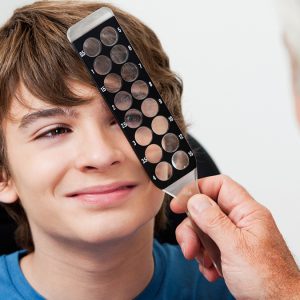How do eye doctors check toddlers’ eyes?
Eye doctors are trained to perform eye exams on non-verbal patients, including toddlers and babies. They use a special technique called retinoscopy to determine if a young patient needs lens correction.

What is a retinoscopy?
Retinoscopy is a simple technique to determine the refractive error of the eye, such as farsightedness, nearsightedness, and astigmatism, as well as the potential need for glasses. The test is quick, easy, and painless, and it requires minimal cooperation from the patient.
During a retinoscopy, a hand-held instrument called a retinoscope casts a beam of light into the patient’s eye. The light is moved both vertically and horizontally across the eye while the examiner observes the movement of the light from the back of the eye. Then, the examiner will introduce different lenses in front of the eye.
As the power of the lens changes, there will be a change in direction and pattern of the reflection. The lens will keep changing until it reaches a power that indicates the refractive error of the patient.
How often should a child get their eyes checked?
Optometrists have the advanced training and tools to perform thorough evaluation of your children’s eyes and vision. Routine eye exams are crucial to ensure your child’s eyes are healthy and make sure there are no vision problems.
Children need visual skills for optimal learning. They should start getting eye exams at 6 months of age, and then at least once a year if no vision corrections are required.
Remember, eye doctors are professionally trained to perform eye exams on young patients, and they do so using a quick and easy technique.
